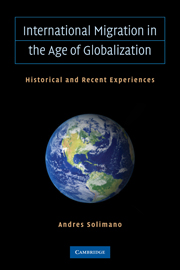Book contents
- Frontmatter
- Contents
- Acknowledgments
- 1 Introduction: Understanding the Trends, Themes, and Strata of International Migration
- 2 Why People Move or Stay Put: International Migration Is the Result of Compelling and Conflicting Factors
- 3 What Happens When International Migration Happens? The Dilemmas Posed by Migration
- 4 How Empires, Policy Regimes, and Economic Imperatives Influenced the Mobility of Capital and People in the 20th Century
- 5 Latin America: Where Volatile Economic Development, Political Crises, Poverty, and Remittance Income Is a Laboratory for Studying the Determinants of International Migration
- 6 Who Migrates and What They Offer: A Focus on People and Elites with Talent, Knowledge, and Entrepreneurial Skills
- 7 A Fair and Orderly International Migration Process Requires a Global Social Contract
- References
- Index
1 - Introduction: Understanding the Trends, Themes, and Strata of International Migration
Published online by Cambridge University Press: 05 June 2012
- Frontmatter
- Contents
- Acknowledgments
- 1 Introduction: Understanding the Trends, Themes, and Strata of International Migration
- 2 Why People Move or Stay Put: International Migration Is the Result of Compelling and Conflicting Factors
- 3 What Happens When International Migration Happens? The Dilemmas Posed by Migration
- 4 How Empires, Policy Regimes, and Economic Imperatives Influenced the Mobility of Capital and People in the 20th Century
- 5 Latin America: Where Volatile Economic Development, Political Crises, Poverty, and Remittance Income Is a Laboratory for Studying the Determinants of International Migration
- 6 Who Migrates and What They Offer: A Focus on People and Elites with Talent, Knowledge, and Entrepreneurial Skills
- 7 A Fair and Orderly International Migration Process Requires a Global Social Contract
- References
- Index
Summary
As the quotations presented in the front matter of this book show, the international mobility of people is a controversial issue, with attitudes ranging from openness and tolerance toward immigrants in good economic times, to reluctance and even xenophobia and resentment, particularly during times of economic slowdowns, unemployment, and financial insecurity such as the one we live in now after the financial crash of 2008–09. From the late 19th century to the mid-20th century, international migration was an important engine for economic growth in such destination countries as the United States, Canada, Argentina, Australia, Brazil, and New Zealand – the so-called New World countries. Most of the immigrants to the New World came from Europe, particularly from Ireland, Italy, Spain, Poland, and Scandinavia, and from Asian nations (although the Chinese were often restricted). In the early 21st century, the geographic landscape of origin and destination countries for international migrants has changed fundamentally. In the last 20 years or so, due to their higher living standards and new economic opportunities (albeit moderate or partially reversed by the financial crisis of 2008–09), Ireland, Spain, Italy, and the Scandinavian and some Asian countries have turned from being, historically, net emigration countries to net recipient countries. These immigrants come from Latin America, Asia, Africa, Eastern Europe, and Russia – countries and regions that, at different points in time, have suffered economic and financial crises and political turmoil, and whose people seek, in foreign countries, more economic opportunities and stability for themselves and their families that are elusive at home.
- Type
- Chapter
- Information
- International Migration in the Age of Crisis and GlobalizationHistorical and Recent Experiences, pp. 1 - 21Publisher: Cambridge University PressPrint publication year: 2010



